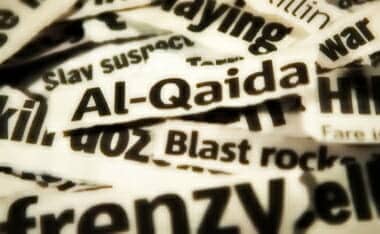Violence cannot be the answer. Anti-fascist must also mean anti-violence. History has proven that anti-fascists like Stalin and Chairman Mao have led to obsessive violence and caused huge losses of life against their own people. Is this what Marxists inspired Antifa aspires to be?
Clarion Project


Legacy Pipe-Dreams for Obama Making Peace with a Death Cult
(Wall Street Journal) While Washington focuses on Iran-U.S. nuclear talks, the Islamic Republic is making a major but little-noticed strategic advance. Iran’s forces are quietly occupying more of Iraq in a way that could soon make its neighbor a de facto Shiite satellite of Tehran.
That’s the larger import of the dominant role Iran and its Shiite militia proxies are playing in the military offensive to take back territory from the Islamic State, or ISIS. The first battle is over the Sunni-majority city of Tikrit, and while the Iraqi army is playing a role, the dominant forces are Shiite militias supplied and coordinated from Iran. This includes the Badr Brigades that U.S. troops fought so hard to put down in Baghdad during the 2007 surge.
The Shiite militias are being organized under a new Iraqi government office led by Abu Mahdi Mohandes, an Iraqi with close ties to Iran. Mr. Mohandes is working closely with the most powerful military official in Iran and Iraq—the Iranian General Qasem Soleimani, the head of the Quds Force of the Revolutionary Guard Corps. Iran’s official news agency last week confirmed Western media reports that Gen. Soleimani is “supervising” the attack against Islamic State.
This is the same general who aided the insurgency against U.S. troops in Iraq. Quds Force operatives supplied the most advanced IEDs, which could penetrate armor and were the deadliest in Iraq. One former U.S. general who served in Iraq estimates that Iran was responsible for about one-third of U.S. casualties during the war, which would mean nearly 1,500 deaths.
Mr. Soleimani recently declared that Islamic State’s days in Iraq are “finished,” adding that Iran will lead the liberation of Tikrit, Mosul and then all of Anbar province. While this is a boast that seeks to diminish the role of other countries, especially the U.S., it reveals Iran’s ambitions and its desire to capitalize when Islamic State is pushed out of Anbar province.
The irony is that critics long complained that the U.S.-led invasion of Iraq in 2003 created a strategic opening for Iran. But the 2007 surge defeated the Shiite militias and helped Sunni tribal sheikhs oust al Qaeda from Anbar. U.S. forces provided a rough balancing while they stayed in Iraq through 2011. But once they departed on President Obama’s orders, the Iraq government tilted again to Iran and against the Sunni minority.
Iran’s military surge is now possible because of the vacuum created by the failure of the U.S. to deploy ground troops or rally a coalition of forces from surrounding Sunni states to fight Islamic State…
[….]
The Sunni states in Turkey, Saudi Arabia, Egypt and the Gulf are watching all of this and may conclude that a new U.S.-Iran condominium threatens their interests. They will assess a U.S.-Iran nuclear deal in this context, making them all the more likely to seek their own nuclear deterrent. They may also be inclined to stoke another anti-Shiite insurgency in Syria and western Iraq.
All of this is one more consequence of America leading from behind. The best way to defeat Islamic State would be for the U.S. to assemble a coalition of Iraqis, Kurds and neighboring Sunni countries led by U.S. special forces that minimized the role of Iran. Such a Sunni force would first roll back ISIS from Iraq and then take on ISIS and the Assad government in Syria. The latter goal in particular would meet Turkey’s test for participating, but the Obama Administration has refused lest it upset Iran.
This from the Clarion Project:
IRAN’S RELATIONSHIP WITH AL-QAEDA
The Clinton, Bush and Obama Administrations all agreed that Iran supports Al-Qaeda terrorists, despite their ideological differences.
In February 2014, the Treasury Department sanctioned three IRGC officers and one IRGC associate for supporting the Taliban and involvement in attacks in Afghanistan. The U.S. government also blacklisted an operative of the Olimzhon Adkhamovich Sadikov, also known as Jafar al-Uzbeki, for assisting Al-Qaeda from Iranian territory.
Sadikov is a member of an Al-Qaeda affiliate named the Islamic Jihad Union and is based in Mashhad, Iran. He assists Al-Qaeda members and other extremists with travel documents to and from Pakistan and Afghanistan. He also collects money for the greater Al-Qaeda network in Iran, where it is distributed to other affiliates such as Jabhat al-Nusra in Syria.
In October 2012, the U.S. Treasury Department sanctioned two Al-Qaeda leaders in Iran that manage its “critically important Iran-based funding and facilitation network.” The two terrorists were:
- Muhsin al-Fadhil, the leader of the Al-Qaeda pipeline in Iran. He arrived in Iran in 2009 and was detained. After he was released in 2011, he replaced Yasin al-Suri as the pipeline’s manager.
- Abdel Radi Saqr al-Wahabi al-Harbi joined the Iran-based network in early 2011 and acts as al-Fadhil’s deputy. He oversees the movement of Al-Qaeda members to Iraq and Afghanistan via Iran.
In July 2011, the U.S. Treasury Department sanctioned six Al-Qaeda operatives connected to an Iran-based “core pipeline” for Al-Qaeda’s operations which enables it to move personnel and resources back and forth from the Middle East to South Asia.
The operatives were:
- Yasin al-Suri, who has served as Al-Qaeda’s representative in Iran since 2005. He oversees the transfer of money and recruits through Iran and negotiates the release of Al-Qaeda detainees held in Iran.
- Atiyah Abd al-Rahman, Al-Qaeda’s overall commander in the Pakistani tribal areas and previous Al-Qaeda ambassador to Iran.
- Umid Muhammadi, an Al-Qaeda facilitator and trainer involved with Al-Qaeda in Iraq. He has used his contact with the Iranian regime to request the release of detained Al-Qaeda members.
- Salim Hasan Khalifa Rashid al-Kuwari, who is based in Qatar and works with the Iran-based Al-Qaeda operatives in arranging travel and money transfers.
- Abdallah Ghanim Mafuz Muslim al-Khawar, who is based in Qatar and delivers money, material and other items to Al-Qaeda’s leaders in Iran. He also makes travel arrangements for terrorists.
- ‘Ali Hasan ‘Ali al-Ajmi is based in Kuwait and works with Yasin al-Suri. He provides travel and financial assistance to Al-Qaeda in general, Al-Qaeda in Iraq and the Taliban.
“By exposing Iran’s secret deal with al-Qaeda, allowing it to funnel funds and operatives through its territory, we are illuminating yet another aspect of Iran’s unmatched support for terrorism,” the U.S. Treasury press release stated.
In January 2009, the Treasury Department sanctioned four Al-Qaeda operatives linked to Iran. They were:
- Mustafa Hamid, who “negotiated a secret relationship between Usama Bin Laden and Iran” in the mid-1990s so Al-Qaeda members could transit the country. He acted as a liaison between the Iranian regime and Al-Qaeda and the Taliban. He was detained in Iran in 2003.
- Muhammad Rab’a al-Sayid al-Bahtiyti is a trusted aide to current Al-Qaeda chief Ayman al-Zawahiri. After the 9/11 attacks, he arranged for Zawahiri’s daughters to travel to Iran. He was detained in Iran in 2003.
- Ali Saleh Husein, who oversaw the movement of Al-Qaeda members to Iran after the 9/11 attacks. He was also detained in 2003.
- Saad Bin Laden, a son of Osama Bin Laden who oversaw the movement of Bin Laden’s family members to Iran after the 9/11 attacks. He also helped manage Al-Qaeda from Iran and was detained in 2003. He was reportedly allowed to leave Iran in September 2008. He was killed in a U.S. drone strike in 2009 in Pakistan.
The Al-Qaeda network in Iran has been tied to plots against the United States. In April 2013, two individuals linked to the network were arrested in Canada as they planned to derail a train going from New York to Toronto. Royal Canadian Mounted Police official James Malizia said, “The individuals were receiving support from Al Qaeda elements located in Iran. There is no information to indicate that these attacks were state-sponsored.”
The relationship between Iran and Al-Qaeda goes back to the early 1990s. According to the 9/11 Commission report, Iran agreed to assist Al-Qaeda in late 1991-1992 in carrying out operations against common enemies, chiefly the U.S. and Israel. Senior members of the group received explosives training inside Iran. Another group of Al-Qaeda members were trained in Lebanon by Iranian operatives in 1993.
“The relationship between al-Qaeda and Iran demonstrated that Sunni-Shi’a divisions did not necessarily pose an insurmountable barrier to cooperation in terrorist operations,” the 9/11 Commission concluded….